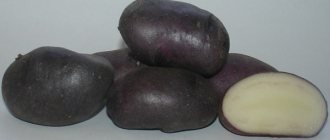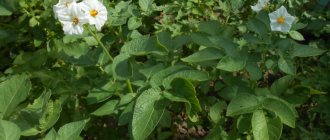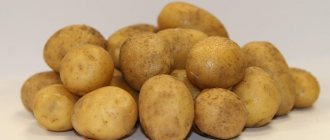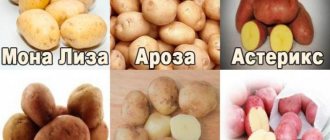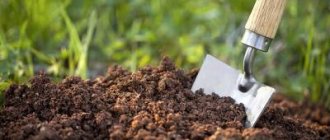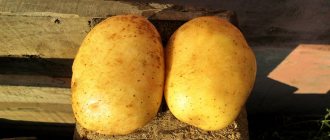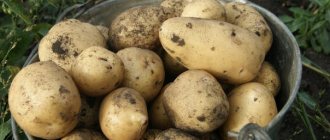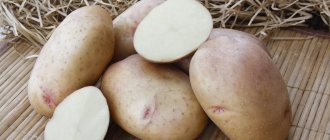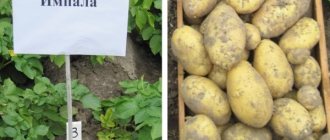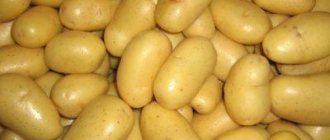Vegetable growing » Potatoes
0
2289
Article rating
Kira Stoletova
Alena potatoes have gained great recognition in the world market due to the fact that they can produce a good harvest, even in areas with short summers and unfavorable soil. The development of bushes occurs at a decent speed, literally in a month and a half. During this time, the fruits fully ripen and accumulate the required amount of necessary elements.
Description of Alena's potatoes
Characteristics and description of the variety
This high-tasting potato was selected at the Ural Research Institute of Agriculture and was included in the state register of the Russian Federation in 2009. It is allowed for cultivation in three regions of the country:
- Volgo-Vyatka;
- West Siberian;
- Uralsk.
Did you know? Potatoes belong to the Solanaceae family, which includes many garden crops that look different from each other: tomato, pepper, eggplant and even tobacco.
Appearance of tubers and bushes
The oval tubers have a red, rough skin and medium-sized, shallow eyes. The pulp is cream-colored with a high starch content (up to 18.9%) and excellent taste. The weight of one potato is 100–130 g, some specimens reach 180 g. The bush is straight with several stems, compact, well developed. The leaves are deep green, large, hard, with wavy edges. The corolla is straight, large, with red-violet flowers of uneven color.
Ripening time
Depending on climatic conditions, care, soil and region, these early ripening potatoes can produce a harvest in a period of 50 to 60 days. In light, well-fertilized soil this may happen earlier, and in heavy soil a little later.
Did you know? Not every type of potato can be bought in a supermarket or market. The La Bonnotte variety, which is grown on the French Mediterranean island of Noirmoutier, has such a delicate taste that the cost of a kilogram of this delicacy is about 500 euros.
Productivity
The Kamensky variety is high-yielding and large-fruited. In a good year, it can bring up to 550 centners per hectare. From 10 to 25 tubers can form on one bush.
Disease resistance
Breeders managed to achieve resistance of the variety to the main pest - the Colorado potato beetle. But the golden nematode can harm the plant. Among diseases, the crop has average resistance to late blight.
Find out more about how to deal with potato diseases.
Frost resistance
When planting plants early, possible frosts can damage and even destroy tender shoots. The stems become glassy at low temperatures and then die. Kamensky has some frost resistance even to Ural frosts, but a prolonged drop in temperature can have a detrimental effect on young plants.
How to harvest
The ripening of potatoes is signaled by yellowed tops. If this happens, it means it's time to harvest. As a rule, the tops fall off in August or September, depending on the planting time. Before harvesting potatoes, the tops need to be mowed 10-15 days before digging begins.
Harvested potatoes in heaps
The work order is as follows:
- The tubers are dug up with a shovel or passed between the rows with a walk-behind tractor.
- After this, they should lie in the sun for two to three hours to dry in order to avoid rotting. It is desirable that the weather be dry.
- The final stage will be collecting root crops in bags or nets.
- The containers are moved to storage areas.
Collection, storage and use of crops
Harvest in September. A week before harvesting, the tops are mowed to get rid of diseases and allow the root crops to ripen.
The dug up tubers are air dried for 6-10 hours. Then the dried potatoes are sorted, damaged and infected root crops are selected. The harvest is harvested for storage in cellars and basements, where the temperature is maintained at no more than +2°C. Humidity should be 90%. The room is sometimes ventilated, and spoiled tubers are sorted and removed once a month.
This variety is considered universal. It is boiled in its skin and used in salads, purees, and first courses. They also make casseroles.
Disease Prevention
The description says that this potato variety quite easily resists all negative diseases and pests. It is not affected by cancer, nematodes and other common viruses and fungal infections. Also, due to its rapid ripening, it is not susceptible to late blight.
This variety was bred by Dutch breeders; in Russia, after several years of successful cultivation, “Alenka” was included in the State Register. Among the characteristics are the early ripening and high productivity of the variety. In less than two months, the tubers have time to ripen and accumulate a large amount of vitamins and minerals. Let us consider in detail the description of the early variety of potatoes Alena.
Features of cultivation
How to grow elite potatoes? You can go to a store or an exhibition and buy elite varieties in the form of tubers. But where is the guarantee that they will sell exactly what you need? Unfortunately, some unscrupulous sellers slip regular tubers in place of the declared ones. In this case, the desired harvest may not be expected.
Many gardeners have learned to grow their own planting material from seeds. They remain viable for up to 10 years and do not need to be stored in a cellar under special conditions. When grown from seeds, all selection characteristics are preserved.
To propagate potatoes from seeds, you must first grow seedlings. This work should begin at the end of February - at the beginning of March. For seedlings, take a small container, fill it with loose soil, and sow the seeds into it. Some gardeners first germinate them in a damp gauze cloth. Before germination, the soil with seeds must be constantly moist.
Young sprouts are very demanding of the sun. If there is not enough of it, the seedlings will stretch out and become too thin and weak. You will also have to monitor the soil, namely, loosen it in a timely manner. If the soil is not loose enough, both the root system and the entire plant will suffer. So, in order for seedlings to grow healthy and strong, they need to be supplemented with light, watered moderately, loosened the soil under them and periodically fertilized.
A month after sowing the seeds, it is necessary to pick young plants. For this procedure, large pots with nutritious soil are used, into which young plants are buried at the level of the cotyledon leaves. In April, all the pots can be taken out onto a glassed-in loggia or balcony.
Elite potato seedlings are planted in open ground at the end of May, when the ground warms up to the desired temperature. Young plants are planted in special holes filled with ash mixed with rotted compost, and watered with water. The stems are placed in the hole in an almost horizontal position and sprinkled with soil up to the leaves. The distance between copies should be approximately 35 cm. Such planting of elite potatoes will allow you to obtain beautiful large tubers in the first year.
To prevent tender seedlings from freezing and getting sick, the beds must be mulched - covered with dry leaves, sawdust, straw or covered with special material. It will be possible to remove the cover and remove the mulch no earlier than June, when hot summer weather sets in.
Subsequent care of potato plantings includes weeding, hilling, watering and fertilizing. A little effort, and as a reward for his efforts, the gardener receives full-fledged tubers, suitable for consumption and for planting next year.
Yield potato varieties: characteristics and description
The first variety of potatoes brought by Columbus to Europe differed from modern tubers not only in size, but also in their bitter aftertaste. The potato did not receive worthy recognition, the reason for this was not only the reluctance of the population to try the “damn apple”, but also the fact that the top of the local government so zealously tried to impose the vegetable on the peasants, who were accustomed to expecting tricks from the nobility. And when the population was massively poisoned by the first shoots, eating “tops, not roots,” mass potato riots began.
Only after much “lamentation” did potatoes finally receive their rightful place among other vegetables and began to be cultivated in most countries. Modern breeders continue to develop new potato varieties, relying on already known tubers that have earned a fruitful reputation.
One of these varieties can be considered the Red Scarlet variety, which is distinguished by its excellent taste, large tuber and resistance to drought. The plant is low-growing, the inflorescences are purple. The tubers are smooth, oblong, blue-pink in color. The weight of one piece potato is about 75 grams. With proper care, the variety's yield is high; you can get 20 tubers from a bush and up to 400 kilograms per hundred square meters of land.
Next on the list of high-yielding varieties is the Gala variety.
Potatoes with stable keeping quality, good taste, large tubers - cannot be replaced in soups, salads and vegetable stews. The tuber weighs about 110 grams and ripens in two months. The yield per bush will be approximately 30 large root crops. The plant is not susceptible to nematode infection.
The Ivan da Marya variety is a resistant plant, with tuber formation in three months. The variety produces crops where others fail. The potato variety Ivan da Marya, bred by Dutch breeders, is called Picasso in Holland. This variety is distinguished by large tall bushes, with white inflorescences, yellow tubers with pink “eyes”. The yield per bush is 20 tubers, with one potato weighing from 110 grams.
The Timo variety is cultivated in temperate latitudes. The variety's resistance to the attack of the Colorado potato beetle, early maturity, dark, green large leaves, tubers weighing 125 grams, high yield and keeping quality are the distinctive features of the Timo variety. Resistant to pathogenic flora and excess moisture - Timo potatoes - produce a good harvest in two months.
The Impala variety can be called a medium-yielding but resistant potato. From a bush of the Dutch variety you can collect up to 10 large tubers, weighing 160 grams per root crop. You can harvest potatoes in a month and a half. Impala is resistant to diseases and has a presentable presentation. The subtleties of cultivating this variety include sufficient heating of the soil during planting and compliance with crop rotation.
The Zhukovsky variety is difficult to damage; its resistance to adverse climatic conditions can be admired. The plant is of medium size, one can call it small and remote. Given the small size of the bush, the yield of a tuber weighing almost 200 grams can be called a breakthrough in selection.
Adretta, a German high-yielding variety, of mid-early maturity, potatoes can be planted in early spring and after two months, you can count on a harvest. The potatoes are boiled, medium-sized tubers weighing 125 grams.
Romano, a variety of table potatoes developed by the Dutch. The yield per bush is high, due to the small size of the fruit. The reddish tuber weighs up to 100 grams. You can harvest a kilogram of potatoes from a Romano bush. The disease-resistant variety begins to ripen two and a half months after planting in open ground.
Luck, a variety that can be called a domestic find for the gardener. Unpretentious and hardy Luck, capable of producing high yields in the most unfavorable climatic zones. Not afraid of cold, drought and heat, the plant grows half a meter in height and meets all consumer demands in terms of quality, appearance and taste.
The above potato varieties are distinguished by high yields at minimal costs, both physical and material, tested by time and more than one generation of gardeners and industrialists. Choose any of the listed varieties, put in a little effort, be patient, and within two months, an environmentally friendly and healthy product grown by you will appear on your table.
Diseases and pests
Alenka potatoes can easily resist major diseases or harmful insects. It is not affected by diseases such as cancer, golden nematode, or fungi.
Due to its rapid maturation, Alena is not susceptible to late blight. But for prevention, some measures must still be taken: plants can be sprayed with preparations containing copper (copper sulfate or Reglon Super, Ditan).
The seed material is treated with chemicals against pests. When planting, you can put insecticides in the holes that will help protect the plants from Colorado potato beetles and aphids. Also for prevention, a folk method is used using wood ash: it is sprinkled on the seed material.
In the event of an attack by the Colorado potato beetle on plantings, it is necessary to take timely measures: treat them with chemicals or collect the pests manually.
Important! In some particularly neglected cases, plantings were almost completely destroyed by beetles.
The early Dutch potato variety Alena is in demand among the population for its good characteristics and excellent taste. Good keeping quality and disease resistance also make the variety popular. Another big plus is that alena almost does not degenerate, and the seeds can be grown independently on a personal plot.
Features of planting and growing varieties
The technique for growing the Lilly variety is similar to other varieties, but there are still some nuances.
Preparing for landing
Potatoes can be cut into pieces; it is advisable to dry them immediately before planting.
The site is prepared in advance. For Lilly, light loamy soil is preferred. It is advisable to plant in an area where beets, cucumbers, cabbage, and carrots previously grew. Acidic soil - deoxidize, fertilize with organic matter, dig up. In the spring, fertilizers containing phosphorus, potassium, and nitrogen are applied.
Dates, scheme and rules of planting
It is recommended to plant potatoes in May; the soil should warm up to +10°C. Holes are dug at least 10 cm deep.
Plant the tubers with the sprout facing down. Plants should be located at a large distance from each other (at least 60 cm), otherwise the tubers will be small.
It is advisable to arrange potato rows from north to south: with this arrangement, the potatoes will receive enough sunlight both in the morning and in the evening.
Features of cultivation
The Lilly variety is unpretentious to care. Standard measures are required: weeding, hilling, prevention of the Colorado potato beetle.
Nuances of care
The main feature of caring for Lilly potatoes is abundant and timely watering.
Watering mode
The Lilly variety needs watering throughout the growing season, especially during flowering. Water the plants at least once a week, preferably in the morning or evening. The water should be warm.
Top dressing
When planting, organic fertilizers - manure or bird droppings - are added to the holes. If desired, it can be replaced with mineral fertilizer with phosphorus and potassium (1 tsp of fertilizer per hole).
During the growing season, fertilizers containing superphosphates and potassium nitrate are applied 2-3 times.
Disease and pest control
The variety is resistant to most common potato diseases. Sometimes plants are affected by the fungal disease late blight.
Treatment and prevention consists of using chemicals according to the following scheme:
- The first treatment is carried out when the bush reaches a height of 20-30 cm. It is recommended to use copper sulfate and copper sulfate.
- Before potato flowering, plantings are treated with Epin and Exciol. If hot weather prevails, use Krezacin.
- For severe damage, use "Oxychom", "Ridomil". The treatment is repeated after two weeks.
- During the ripening period of the root crop, the plants are treated with the drug "Alyufit".
Lilly potatoes are susceptible to attack by the Colorado potato beetle, aphids, and mole crickets. To control pests, it is recommended to use the following drugs weekly: “Bitoxibacillin”, “Akarin”, “Fitoverm”, “Korado”, “Zubr”.
To prevent potato infection by diseases and pests, it is recommended to treat the seeds before planting with such preparations as: “Prestige”, “Epin”, “Bioglobin”.
Rules for caring for the variety
While the potatoes are ripening, weeding and hilling must be carried out regularly. In dry years, drip irrigation can be used to moisten the soil and retain moisture. To retard the growth of weeds, dry grass or straw can be laid between the rows.
Recommendations for hilling
Hilling is carried out when the height of the bushes reaches 10 cm. After two weeks, the procedure can be repeated.
Before hilling, the area is weeded and moistened. Moisture is especially needed during the period of bud formation and flowering: at this moment, tubers form. If there is insufficient moisture, the potatoes will be small and will bring only disappointment when harvesting.
Advice ! A few days before harvesting, you need to feed the bushes with phosphates. This allows the tuber to absorb the necessary elements from the tops.
Features of cultivation
Since the fruits are underground, it is necessary to provide optimal conditions for the development of the root system and the successful formation of tubers. Also, an important condition for successful growth is lightness and looseness of the soil.
To grow the Gulliver potato variety, you need nutritious soil, chernozem.
Before planting, the seed requires additional processing - it is laid out in sunlight for a while so that it “greens up”. It is also recommended to germinate the seed, which will stimulate germination and contribute to an earlier harvest. To do this, a month before planting, the tubers that were selected for germination are laid out in shallow boxes in one or several layers and left in a well-lit room with a temperature of +15...+17˚C.
The readiness of the seed is determined by the presence of sprouts on the tubers and the green color of the peel.
Growing conditions
A number of conditions that will help ensure the growth and development of potatoes in the garden:
- The soil. The optimal soil for growing Gulliver is chernozem, since it has a large amount of nutrients and minerals. The growing soil should not contain large amounts of alkaline substances. If the acidity of the soil is high, then it is reduced by adding lime to the soil.
Temperature. Seeds and seedlings of this variety are very sensitive to low temperatures and sudden temperature changes, so it is recommended to plant them in open ground only when the risk of frost returning to the soil has disappeared. It is permissible to germinate potatoes when the soil warms up to +5...+8˚C, but for the development and growth of the bush it is required that the soil is no cooler than +16...+18˚C.
Lighting. Growing seedlings requires a lot of light, so they are grown indoors with sufficient natural light and, if necessary, provide artificial lighting.
Humidity. The formation and development of the vegetative mass requires a large amount of moisture, so intensive watering is necessary for the bushes mainly at the time of tuber formation.
Soil aeration. Air access to the root system of potato bushes is a necessary condition for growing a good crop, so soil care involves performing regular work to loosen the soil.
Landing dates
You can start planting Gulliver in the ground only when the soil has warmed up sufficiently, which depends on the region of planting and weather conditions. The main thing is to eliminate the possibility of frost, which can destroy the seedlings. Tubers can be planted to a depth of 15 cm when the soil is heated to +8˚C.
Did you know? Indian tribes living in the region of modern Peru were the first to cultivate potatoes. Their civilization knew almost 200 varieties of this root vegetable.
Selecting a location and preparing the bed
The planting bed should be located in a sunny area of the garden, since potatoes react very positively to good lighting. Soil preparation begins in the fall, when the soil is fertilized with humus or fresh manure. If such preliminary preparation of the soil has not been carried out, then nutrients must be added to each hole directly during the planting process. To do this you will need:
- loose humus;
- superphosphate;
- wood ash.
If groundwater is located close to the surface of the earth, then it is recommended to plant potatoes in high beds, since their root system is very developed and can suffer from excess moisture: prepared seed is placed in the earth furrows, which is covered with a soil ridge up to 15 cm high.
Before you start planting potatoes, you need to prepare the bed by first moistening the soil and loosening it.
Technology and planting scheme
The planting technology of this variety has no distinctive features and involves:
- Preparation of furrows, the distance between rows should be within 70 cm.
- Digging holes. At the same time, their depth should be 8–10 cm, and the distance between them should be 35–40 cm, in order to ensure the development of the root system and prevent deterioration in yield due to planting twisting. When digging the next hole, the previous one is buried.
- A sprouted tuber is lowered into each hole.
- After planting, the entire surface of the garden is leveled using garden tools, which helps retain moisture in the soil.
Video about the variety “Alena”
Unfortunately, there is no video for this variety at the moment. We invite you to watch the video section of our website, where other videos about potatoes and other agricultural crops are posted. We and the entire farming community will be grateful if you send us your video or link about this variety from YouTube or any other video hosting service. If you see this message, it means that we have not yet been able to find a suitable video for this variety.
Similar articles:
Potatoes and all their varieties in detail here → Potato variety “Bryansk New” - description characteristics reviews photos video
Potatoes and all their varieties in detail here → Potato variety “Borus” - description characteristics reviews photos video
Potatoes and all their varieties in detail here → Potato variety “Bonnie” - description characteristics reviews photos video
Potatoes and all their varieties in detail here → Potato variety “Bellarose” - description characteristics reviews photos video
Potatoes and all their varieties in detail here → Potato variety “Bashkir” - description characteristics reviews photos video
Growing rules
For planting in the ground, you should choose only those fruits that have a beautiful appearance, are free from diseases, and they should be small in size. In order to prevent diseases and accelerate the growth of seedlings, it is necessary to treat the seeds with Fitosporin. Also, to improve productivity indicators, it is necessary to fertilize the soil with both mineral and organic fertilizers. But it is best to alternate these two feedings.
In order not to risk the harvest due to insufficient moisture, it is better to install drip irrigation. This will allow you to regulate the water balance of the soil and prevent the potatoes from forming incorrectly. Also, such potatoes do not require special care. Before planting, it is necessary to treat each potato with special chemicals that will protect it from negative effects.
It is also necessary to put humus in each hole. Between the bushes you need to maintain a distance of 30 cm. But between the rows you need to maintain a distance of 80 cm. During this month and a half, you should hill up the potatoes several times, and do not forget to remove all weeds from the soil. To increase the amount of future harvest, you can put straw or dry grass between the rows.
Before harvesting, a few weeks before, it is necessary to feed all the bushes with special phosphates. This will allow the tubers to absorb all the necessary substances from the tops and ripen faster. Before you start harvesting, you need to remove all the tops. After digging up the tubers, you need to hold them in the sun for a while to dry them better, and only then move them to storage areas.
Advantages disadvantages
From the description above, one can already note the main advantages of the variety. There are many more of them than there are minuses.
- excellent taste;
- high productivity;
- storage rates are high;
- withstands transportation well;
- can grow on any soil;
- the variety is drought-resistant;
- potatoes are slightly susceptible to diseases;
- adapts to adverse weather conditions.
There are no obvious deficiencies in the variety. But to get a really good harvest, you will have to carefully study the cultivation technology and adhere to agricultural techniques.
